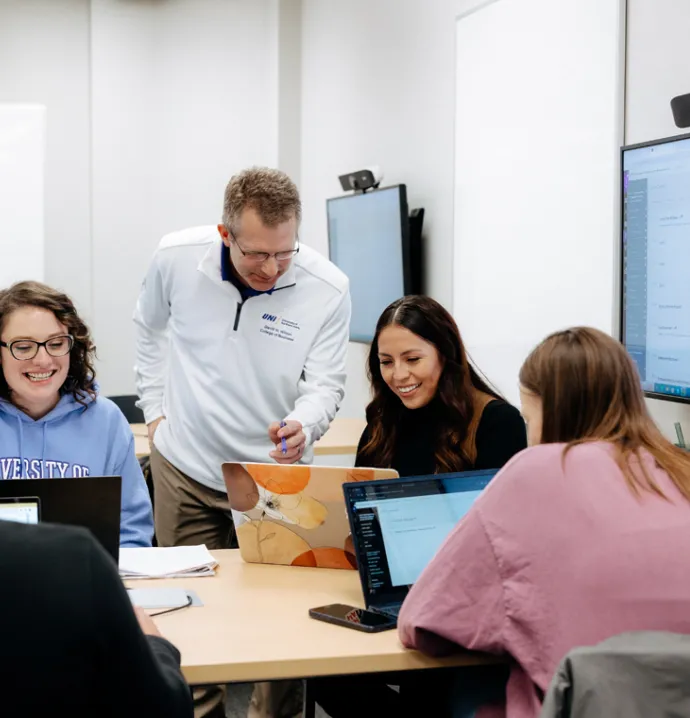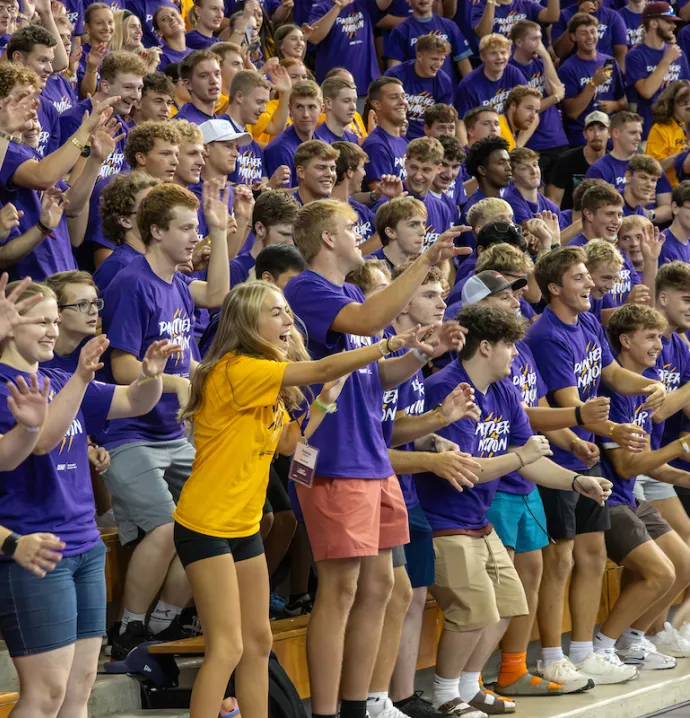Protests, prisons and COVID-19: An interview with Alison Cox
Protests, prisons and COVID-19: An interview with Alison Cox
Despite crime rates that have fallen for decades, the United States still imprisons far more of its population than any other country in the world. COVID-19 has forced Americans to take a closer look at our society — including the millions behind bars in jails and prisons where infections are hard to contain. While some county jails have released thousands of detainees to slow coronavirus’ spread, prisons have been reluctant to follow. Penal institutions in recent weeks have seen a surge in cases — the total has nearly doubled — and deaths from the disease have reportedly increased by 70 percent since May.
We asked UNI Assistant Professor of Criminology Alison Cox, an expert on the impacts of incarceration, to weigh in on this and other pressing issues in the criminal justice system — including how this historic moment could lead to lasting change.
First of all, can you tell me a little bit about your expertise area in regard to criminology/criminal justice? What is the difference between each area and how do they work together?
My research areas largely focus on corrections and the carceral state. I am primarily interested in prisoner’s families and how incarceration impacts relationships with their incarcerated loved ones. I identify myself as a feminist criminologist, so I am also interested in women and gender issues in criminal justice. As an assistant professor of criminology, my expertise primarily lies in the area of criminology, but I also have professional experience from the field and thus am adept in addressing topics in criminal justice as well. Sometimes it is hard to recognize the difference between these areas as they do tend to work hand-in-hand in one another. A simple way of distinguishing the two could be: Criminology focuses on the theory behind why some people do or do not commit crime. Theory matters because it impacts everything across the criminal justice system starting from what we as a society deem as criminal, the laws we develop to control criminal behavior, how we punish those who break the law, and how we try to prevent or deter others from doing the same. Whereas, criminal justice focuses on both the individual and exchange relationships between the three major systems: police, courts and corrections. This part of our field is more practitioner-based and looks to the day-to-day actions of the police, the courtroom workgroup (prosecutors, defense attorneys and judges) and correctional personnel. It is important to remember that “corrections” not only includes those who are housed in jails and prisons — and those who work there — but also the areas of probation, intermediate sanctions, and parole and re-entry.
People in prisons and jails are at an increased risk of contracting COVID-19. What are some of the reasons this community is uniquely vulnerable to the disease?
While some might think that being “isolated” in these spaces might be a decent way to socially distance or quarantine, prison and jails are, in fact, the complete opposite — conditions are crowded and unhygienic. They are essentially petri dishes for infections and disease. The reasons incarcerated populations tend to be more vulnerable to the disease are numerous. To begin, populations involved in the criminal justice system already have an increased prevalence for infectious diseases such as Hepatitis C, HIV and tuberculosis. On top of that, there are structural disparities that incarcerated people overwhelmingly experience. For example — being Black, Indigenous, Brown or a person of color; a person experiencing homelessness or housing insecurity; being an undocumented citizen; having a substance abuse disorder; or navigating severe mental illness. Of course, also having limited or no access to healthcare, education and residing in neighborhoods that are both economically and socially disadvantaged do not help the situation either. In short, people in prisons and jails are already experiencing comorbidities that make them vulnerable to infectious disease in the first place. Once they are incarcerated, they become even more vulnerable.
Part of what’s led to the spread of COVID-19 in prisons is the high capacity. Why does the US incarcerate so many people? Has this led to more safety?
This is where it comes in handy to be an expert in both criminology and criminal justice. Due to how we think about crime — including the policies that we generate to control and prevent it — has resulted in an over-reliance on incapacitation for the past forty years. While we have now come to recognize this over-reliance as mass incarceration, we are still reeling from these uninformed — and frankly, hurtful — policies. The United States incarcerates more people than any other country in the world. While correctional populations are starting to dwindle, there were still 2.2 million people incarcerated in U.S. prisons and jails at the end of 2016. While criminal justice scholars aim to conduct research to help develop evidence-based policies and practices, this is a societal institution that is highly politicized. Therefore, evidence-based practices can easily be overlooked — or outright ignored — if it does not sound “sexy” enough, or isn’t going to be “tough on crime” as politicians and practitioners hope them to be. This is especially the case when it comes to the U.S. correctional system. Instead, U.S. prisons and jails tend to operate more on what they think “works,” which tends to result in ineffective punishment and sentencing practices, ineffective policies to control and prevent crime, ineffective efforts to incapacitate, and ineffective efforts to provide rehabilitation and reentry initiatives once people are released back to their community.
Has all this led to more safety? Based on the empirical evidence, not at all. It has led to more trauma and pain to the person experiencing incarceration, their loved ones and the communities they are returning to. All the money spent on incarceration is also money that is being diverted away from education, health care services, community programs and other social services that might actually do a better job of controlling and preventing crime than current correctional practices. Furthermore, when compared to people sentenced to probation, recidivism rates tend to be higher for those sentenced to serve time in jail or prison. When it comes to incarceration, we are wasting our time, money, and more importantly, we are doing more harm than good. We are doing more injustice.
How else has the pandemic forced us to think differently about jails and prisons? Do you think that will lead to lasting change?
We have focused on mass incarceration for the past 10 years. Michelle Alexander wrote "The New Jim Crow" in 2011. Recognizing the numerous collateral consequences related to incarceration, in addition to just how much money we spend on it, some states have made efforts to decrease their incarcerated populations. This is the first step; but it is a first step of many that need to come. Now that we are in 2020, I believe this pandemic has forced us to start putting ideas and initiatives that have been discussed since Alexander’s book — really, well before her 2011 publication when you read the writings of Angela Y. Davis — into practice. Don’t get me wrong — several prison and jail initiatives have been made since and continue to do the work — but I have noticed more conversations around prison abolition and other progressive criminal justice reform that have long been ignored for being too “radical.”
Some other examples include calls for “decarcerating” or releasing as many people as possible — especially the elderly, infirm, and those who are least likely to commit additional crimes; urging the police and courts to immediately suspend arresting and sentencing people as much as possible; eliminating the cash bail system; recognizing mass incarceration as a public health emergency — not solely a criminal justice issue; and investing in the root causes of crime (e.g. expanding education and economic opportunities). As many public health professionals, criminal justice scholars, and advocates have discussed, the COVID-19 pandemic is an opportunity to push for more reforms to reduce prison populations and to move toward a more humane evidence-based healthcare system for those involved with the criminal justice system.
Talking about human rights issues in the context of prisons and jails also brings to mind current conversations happening surrounding use of force by police officers. Who decides how much force is necessary? Who creates the policies that guide not only how police are trained to use force, but how we deal with officers who use excessive force?
The issue of who decides how much force is necessary — or if police force becomes excessive — is complex. For instance, while definitions of deadly force have been laid out in Supreme Court rulings (Tennessee v. Garner) or by the Department of Justice, it is unclear what should be considered excessive due to the amount of discretion that is afforded to police departments and their individual officers. As for who creates the policies that guide how much force is legitimate versus excessive is a combination of departmental policy and court rulings. We also have to remember the civil rights and due process afforded to us through procedural laws identified in the Fourth, Fifth, Sixth, and Eighth Amendments. There is so much more to these Amendments beyond having your Miranda rights read (recognized in the Fourth Amendment), having the right to counsel (Sixth Amendment), nor the use of excessive bail or fines imposed (Eighth Amendment). They also address issues related to police use of force (excessive or lethal) and that searches and seizures do not result in “unreasonable harm” during a stop or an arrest. However, how we define what is “excessive” or what is “unreasonable” or what even “harm”’ is, is quite broad. Furthermore, these definitions are left up for interpretation again, by the individual officer in that particular situation, or by a judge reviewing their actions after a victim files a lawsuit claim over police brutality to see if an officer’s actions have caused harm, injury — or worst case — death. Ideally, the police and public should work hand in hand to protect and uplift communities. Similar to jails and prisons, the COVID-19 pandemic has also laid out the inequities and injustices that remain present in law enforcement agencies.
With so many people attending protests, and some protesters being jailed temporarily in cramped cells, do you think this will lead to a surge in COVID-19 cases? How does this speak to some of the general reasons for the high spread among jail and prison populations (outside of a surge due to protests)?
I fully support the protestor’s efforts, but I am also concerned that contact between large groups of people and law enforcement will aid in producing another surge in COVID-19 cases. Of course, it does not help that these crucial social movements are happening at the same time that a majority of states are reopening. Furthermore, if protestors are arrested, taken to jail and eventually released back into the community — their chances of being exposed to the virus are that much higher. In turn, this could lead to an increased chance of community spread. Again, it is the design of carceral spaces. You cannot social distance. You cannot quarantine. You cannot even receive the basic sanitation and hygiene practices you need to combat the virus. Just as of last week, new research came out demonstrating how significant a role the Cook County Jail in Chicago has played in spreading the coronavirus: Nearly 1 in 6 COVID-19 cases identified in all of Illinois by mid-April were associated with people cycling through the jail . Another concern, and one more related to policing is the repeated use of tear gas on groups of protestors. It has recently been reported that corrosive effects of tear gas could intensify coronavirus pandemic. Some researchers have even stated that police using tear gas or pepper spray is “irresponsible” during a pandemic as they make people cough droplets and damage the airways in ways that will make them sicker from COVID-19.




